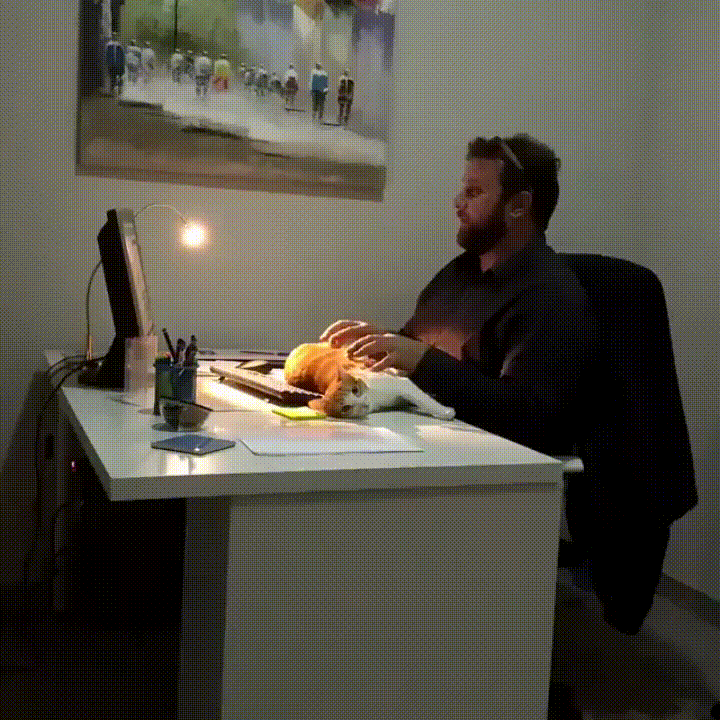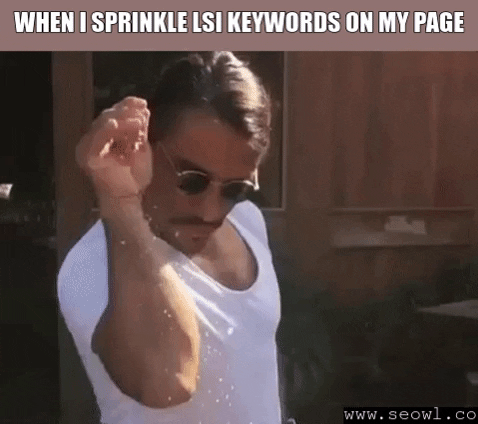Wondering how to create an enterprise SEO Strategy?
The SEO for “Search Engine Optimization” is to optimize the referencing of its website on certain keywords searched by internet users, in order to answer their questions and highlight its content and/or services.
Let’s see together how to start your organic SEO strategy. 😊
Despite it being a trendy topic (many people talk about it), it is largely underestimated and underutilized. There’s even an air of mystery around it with most companies. 👻

And for good reason, a few agencies are lining their pockets well by making this marketing strategy appear complex and selling overpriced services that aim to make you appear high up in Google’s results. 😅
It’s true that to come up high in the rankings for a keyword like “car insurance” or “buy jeans” is going to take a lot of effort and time, especially if your site is just starting out. And there is even a chance that you’ll never rank highly.
But there are other strategies which allow you to apply Pareto’s principle so that with 20% of the effort you can obtain 80% of results.
At Waalaxy, about 30% of our acquisition is generated by our seo strategy and today, with a team of about 20 people, we have exceeded 100,000 monthly visitors.
That’s why, during a recent live, our Head Of Acquisition, https://blog.waalaxy.com/wp-content/uploads/2021/05/Capture-décran-2021-05-20-à-16.34.07-1.webp Bart, shared with us all her secrets to achieve such a result. You can contact her on LinkedIn if you have any questions.
P.S.: She communicates mainly in Gifs. Feel free to send her lots of them. 😎

We’ve transcribed it all for you here. And you won’t be disappointed 😉
NB: to ensure you don’t miss more content like this and share best practices for finding clients, join our community!
Enterprise SEO strategy and content strategy: why combine the two?
Before we start, I just need to clarify something. In this article, we’re going to talk about SEO as a content strategy. But essentially: how to set up your seo strategy.

We’ll come back to this a few times but you need to know something. To get listed on Google (and other search engines), you must try to answer the questions of use.
The problem is that you can’t answer relevant questions with just a “showcase” site. In other words, your main site that serves as a sales page cannot suffice in an SEO strategy. That’s why we’re going to talk about content, in the sense of blog articles or pages richer in text. The objective is to position yourself in response to keywords on Google (With less than 300 words, Google’s robots do not even go on your page).
That’s why it’s almost essential to have a blog, either directly in the architecture of your site (in the waalaxy.com/blog format), or on a separate blog, as a sub-domain, like blog.waalaxy.com. It is now very easy to launch a blog with WordPress and thousands of tutorials exist on the web to help you do it.
All this to say that today, we are going to talk a lot about articles, text content with the objective to rank on Google and, then, how to convert the customer on your main site (therefore resulting in a purchase).

Why bet on an enterprise SEO Strategy?
1. Exponential results
One of the fundamental things you need to know about SEO is the long-term aspect. SEO is a painstaking task, the results of which are only felt several months later. Each iteration takes time to have an impact, and that’s kind of what makes it a “mystical” thing. 👻
No one other than Google really knows how their algorithm works and many are speculating, looking for the best hack to rank first in the results. The truth is simple and it’s the same for all types of content: consistency and persistence are the keys to a strategy that works.
Hacks can add value, but a seo strategy cannot be based on them. I am not trying to discourage you because it is the long term aspect that is interesting in SEO. Indeed, the progression curve in SEO is an exponential curve. It takes a while to take off. But when it does take off… it takes off. 😍

The results are just huge. You could say this is an acquisition channel that scales. Personally, I think it’s great. An article we write today that will get 100 views in the first month will get maybe 10k views a month in a year.
This is the opposite of other types of content, mainly those on social networks, whose lifespan is counted in days or even hours. 🕦 To illustrate, here is our organic traffic curve (so only via search engines) over the last 2 years :

2. The advantages of SEO
In two words: Lifetime capitalization and competitive advantage. In keeping with the exponential results, one of the huge advantages of SEO is “lifetime capitalization”. This materializes via two things:
- Time passes, content stays. One of the most read articles in our house is more than 18 months old despite the fact that we have released hundreds of other contents since.
- Dislodging a site from its position 1 is very difficult. Indeed, Google tends to consider that the more your site is visited on a keyword, the better it responds to that search. Therefore the more chances you have to move up. When you are 1st on this keyword, it makes you almost indestructible.
Contrary to prospecting or advertising, which, when budgets are cut, stop producing results, SEO continues to provide long-term results. Even when we no longer work on it.
3. SEO and Conversion Intent
Unlike prospecting or advertising, which are “outbound” strategies, SEO is an “inbound” strategy when we look for leads or advertise, we go looking for users by trying to predict who might be interested in our service, product or content.
Yes, we cast the fishing rod. And we hope it bites. 🐟 SEO is the opposite. It’s fishing with a net. We set a net, and let the fish get caught in it. (Sorry to compare you to fish if you arrived on this article by one of these techniques 😂).
Basically, we’re going to answer questions that our potential customers have and position ourselves on topics that interest them. An example of one of our ultra-optimized articles right here. If I take our example, we work our SEO strategy on everything related to prospecting strategies, LinkedIn and emailing.
And now that we’ve covered these topics, we expand by talking about Growth Hacking and any type of acquisition strategy. Like this article. 😊 So what’s interesting is offering a response to someone who shows an interest in a topic.
If I’m looking for “best dishwasher 2021”, I’m probably looking to buy at a dishwasher. So if you sell dishwashers, you’d better position yourself on this type of keyword. Because the chance of converting behind it is very high. ⭐️
And that’s a huge competitive advantage. Because if you’re visible on that keyword and your competitors aren’t, in a world where 80% of buyers do a Google search before buying a product, you’re not giving them a chance.

4. SEO and Visibility
SEO plays on several marketing levers. The first one we talked about above is the conversion objective. The user is looking for a product or is at least in a buying behavior. We will try to push our product or service.
And then there is the “awareness” content. Like a TV commercial, the objective is not for the visitor to go and buy our product immediately after reading our article or visiting our site. We will try to answer in a qualitative way to the questions that they ask themself on a subject related to the problem that we solve.
SEO is therefore a way to make ourselves visible to large volumes of people. 👩🚀 (We’ll get back to this a little later, as well as the different types of content).
5. SEO and Content Distribution
Finally, SEO is a great way to distribute your content and set up a “content factory” (to learn more about this topic, read our article on inbound marketing strategies).
When I say “distribute your content”, I mean:
- Share your knowledge on your subject of expertise, to bring value to your future or current customer, and to highlight your expert status.
- “Repurpose” another piece of content. I also like to call this “recyling” and it is a fundamental aspect of your “content factory”. For example this article is a summary of a video content, done live in front of 300 people. We take it back and reformat it into text, to target other channels and other types of people, but without having to start from scratch on the content. 😜
- Expand to other countries. We won’t address this aspect today, but know that once your SEO strategy has advanced well, using content translation to easily expand internationally is a great growth lever.

How to start your enterprise SEO Strategy? The 3 pillars
As you can imagine (and as you’ve probably already understood), this article is not intended to make you become an SEO pro. If you are one, you must already be shitting yourself reading this article. 😅
No, the objective, like most of the content we create, is to give you the keys to start your seo strategy, at a lower cost and reduced human resources.
All with actionable tips and concrete examples. But you still have to start with the basics. SEO is based on 3 fundamental pillars: technique, content, and links.
1. Technique: Optimizing your site for SEO
The first thing to do when you want to be properly referenced on a search engine is to optimize your site so as to meet Google’s criteria.
(Yes, we are going to talk about Google which represents 96% of the searches in the world and whose criteria are then copied by its competitors).
When we talk about an optimized site, we are talking about a site that offers a good user-experience, and more.
A fast loading and light site
It is estimated that a user leaves a site if it takes more than 3 seconds to load.
Google‘s business being to reference sites for its users, it will seek to offer the best possible experience to the internet user. 😊 So the site must be optimized to load quickly. For that you can apply some of these techniques:
- Minimize site javascript,
- Compress images,
- Avoid heavy animations.
You can do an audit of your site on Page Speed Insight, a tool provided by Google itself to know what to optimize on your site. A little more technical, Pingdom Website Speed Test. Both these tools are free.
A structured site
As much for the user as for the Google robots that browse your site, it must be well structured. We mean:
- Well-chosen categories that make sense so it’s easy for users to find what they are looking for,
- Relevant titles that are evocative of the content,
- A sitemap and a robot.txt well organized. These are files at the root of your site that give indicators to robots on how it is built and helps them understand what you do. There are plenty of tutorials on this subject as well as tools that help you build them properly.
- A respected HN tag structure!
Example of the structure of our site:

You can view your structure with the Chrome extension “Document Outline”. 😄
A site that is pleasant to visit
Your site should offer a good overall user experience. We mean:
- A beautiful site.
- A responsive site (ie that adapts to all screens). Indispensable today.
- Avoid popups, invasive ads and anything else that alters the browsing experience.
Google Search Console now offers a tool to analyze your site in mobile and give you tips for improvements. In short, whatever youyourself find boring when you check out another site = don’t do it. 😋

Optimizing your site on WordPress
For those who don’t know, WordPress is the most used tool in the world to create sites and blogs without coding a single line.
One of the big advantages is the huge community and plugins available. If you’re just starting out, look no further than WordPress.
Here are the tools we use to optimize our blog technique on WordPress:
- WP Rocket (paid but the most efficient). Takes everything you have on your site and compresses it to make it load faster.
- Huming Bird & Robin Image Optimizer: automatically optimizes and compresses all your images.
- Web P converter: takes your JPG & PNG images and converts them to .webp, a format preferred by Google.
2. SEO and Content: responding to users
Why create content?
We have discussed it quickly above. The purpose of creating content is to position yourself on certain specific keywords. We seek:
- To become an expert on a subject. The more we talk about it, the more Google will see that we bring value on this subject, the more it will reference us on these subjects.
- To give answers. Google is an answer engine, and less a search engine. We must therefore seek to answer questions with clear, concise and precise answers.
- Feed the search engine. Google is like a car. Content is the fuel. Google needs to feed on content to understand what we do, who we are and therefore to increase its trust in us. 🚗
What content to create?
Now that we know why to create content, we have to find what content to create. Because writing answers to questions that no one asks is of zero interest. For this you have two free and efficient tools:
- Answer the public. You give the public a topic and they come back to you with the most asked questions on that topic and how those questions are asked.
- Keyword tool. Similar to the previous one.
And finally 1.fr (a paid tool), which will provide you with more precise questions, often on more niche topics (which is less competitive).
It also gives you the words to place in your article to ensure your content has the keywords that answer the question.
Ps: this article has been optimized with TextOptimizer. 😜
Which keywords to target?
To find the best keywords to target, you have to look for the best volume/competition ratio. In other words, there is no point in directly targeting the word “insurance” which is ULTRA competitive and on which you have no chance to position yourself. Because the important thing is to get traffic.
The more traffic you make, the more Google trusts you, the better you rank and the more traffic you make. ❤️ When you know that more than 2/3 of the traffic is on the first 3 results, it is better to be 1st on a keyword with 10 searches per month, than 100th on a keyword with 100,000. We will therefore look for small search volumes (and little competition).
Often these are keywords that we will call “long tail”, meaning, precise questions. For example “how to automate my prospecting on linkedin?” rather than “linkedin prospecting”. A good way to check the competition on a keyword is to search for the keyword between quotation marks.
The number of results corresponds to the number of sites that are positioned on this keyword.

Below 1,000 we start to be on a level of competition achievable. Below 100 it’s very uncompetitive.
Above 10,000, at the start, is very complicated.
Above 100,000 it is impossible (as a start-up).
The 3 types of content in SEO
At Waalaxy, we distinguish 3 types of content on our blog:
- The content with high added value: these are articles that will obviously be referenced on Google but in which the main concern is to answer a customer problem. These articles are often distributed via other channels than SEO and do not necessarily correspond to Google searches.
- Support content: these are tutorials and case studies that are shared with our users so to provide answers to their questions related to the product. And since we are not yet well known, few people search for them directly via Google.
- SEO content: this is content where the sole thing that counts is ranking in Google searches.
Among these SEO content, we distinguish 3 subtypes:
- The conversion content. The objective of this content is to answer a precise user question and where possible to put forward our tool. It could be an article on “how to find leads on LinkedIn” or “the best prospecting messages.” 🤝
- Traffic content. This is more “generalist” content, which strays a bit from our core subject. We can mention “LinkedIn emoji” or “LinkedIn carousel”. A lot of traffic but less qualified leads. The objective here is to build our brand image, without trying to immediately convert. There’s also the additional goal of getting more traffic so as to improve our image with Google.
- The “guides”. These are very long contents (>5k words) with often multiple objectives: to position oneself on a very competitive key query (Google likes long articles), to position oneself on dozens of small searches with little volume but little competition; thus bringing a lot of value to the user (which can lead to a conversion). We can cite “linkedin lead generation strategy” as an example. This guide aims to present the main strategies to find customers on Linkedin. 😎
3. Links: Achieving Google’s trust

The third pillar of SEO is “links”. Also called “backlinks “. It’s about determining how many people are talking about you on the web and if these people are trusted sources.
Yes, Google does not want to send its users to dubious or unreputable sites.
On the contrary, it wants important/expert sites to be well positioned. So we can say that there are 3 main closely related indicators when we talk about link strategy:
- The level of trust: who is talking about you? Rather sites that Google has little confidence in or rather reliable sites like important media, directories or other reference sites? Without a doubt the most important indicator.
- Citation volume: how many people are talking about you? This indicator must go with the level of trust. If there are few reliable sites talking about you and many unreliable sites talking about you, this is not good.
- The category of your site: depending on your content and the types of sites that talk about you, Google will assign you a majority category and sub-categories. You will be considered as an “expert” on x or ysubjects and therefore more likely to be referenced on the keywords of these subjects.
How to get links?
A link strategy is also built on the long term. Nevertheless, there are some tips to get important links pointing to your site:
- Free directories: the Oueb, Netgo,
- Write articles on Medium, make a public Notion page or create a Wikipedia entry,
- Exchange links via “guest blogs“: you write an article on a partner’s site that has the same theme, they do the same and you each send a link to the other.
- Rely on ambassadors. In our case we have an affiliate program and encourage our ambassadors to write content about us to get links.
- Buy links on platforms: ereferer, getfluence, semjuice…
A link strategy should be seen in terms of regularity and not quantity.
It is better to have one link per month for a year than 12 the first month and then nothing. 🛑
5 tips for getting started an enterprise SEO strategy
To finish this article, here are 5 general tips to remember for a successful SEO strategy.
Tip #1: Think user
It’s been a while since you could just place 100 times a keyword in your text and be positioned. 😂 Today, the key to SEO is the user.
Because Google wants to offer the best to its visitors. So you no longer try to write for robots but for humans (because these robots try to get as close as possible to how a human would feel).
The robot goes through the site. The site must be fast, beautiful and pleasant, as mentioned, but it must also have content that brings value to the user and that is easy to read. 👨🍳
Chief’s tip: your content must be pleasant to read aloud.
Long-winded sentences and pompous formulas should be banned. GIFs, memes, illustrations, emojis are welcome!
Tip #2: Provide an answer
We’ve said it before, but better too much than too little. There are only 10 places on the first page and the first 3 results capture almost all the traffic.
The competition is tough so you have to be the best at providing the answer. Whoever offers the best answer the earliest in the article wins. ❤️ 👨🍳
Top tip: to beat your competitors, type your keyword into Google. Read the first 3 articles.
Then write down: what you would have liked to read more of, what you found irrelevant to answer the question, what information you didn’t find.
Redo your article taking into account those points, and add 10 to 20% more content.
Tip #3: Simplify your searches
Use the “Keyword Surfer” extension that gives you search volume information directly on your Google page when you search for a keyword. 😍 
Tip #4: Take inspiration from competitors
There’s no point in reinventing the wheel. Your competitors have probably already answered similar questions.
Take inspiration from their content and do better (better answers and more content). You can also, with the Semrush tool (not free), look at what brings the most traffic to your competitor and position yourself on the same searches, trying to create better and longer content.

Tip #5 : Regularity > Quantity
Whether it is for links or for content, it is the regularity that takes precedence over the quantity. SEO, like content in general, is more like a marathon than a sprint. Consistency is one of the keys to success. ⭐️ So opt for 1 article per week rather than 50 articles at once.
In general, Google does not like “extreme events”. Anything out of normal and consistent behavior tends to alert it, and you may get the opposite effects of those expected. 👨🍳
Top tip: If you’re all alone while implementing an SEO strategy, organize yourself into “sprints” during which you isolate yourself and write several articles in an allocated time period.
Then schedule these articles so you’re always ahead of the game and never get caught short.
Conclusion for your enterprise SEO strategy
Should you start an enterprise SEO Strategy? I think that after reading this article, the question is quickly answered. 😎 It may seem like a lot but it’s worth it.
Feel free to join us on our community to discuss this topic and get advice from other members! 👽
Article FAQ about enterprise SEO Strategy
How to translate your SEO articles?
To translate your content into different languages, you can choose to use native freelancers. It’s quite expensive but your content will be of a high quality.
At Waalaxy, we translate our content using native speakers; from French to English and Spanish.
For the rest, all our articles are automatically translated (and reoptimized) thanks to DeepL and a WordPress plugin (DeepL for wordpress).
Can I start an SEO strategy by myself, without any prior knowledge?
Of course you can. And that’s totally the idea of this article.
That’s what https://blog.waalaxy.com/wp-content/uploads/2021/05/Capture-décran-2021-05-20-à-16.34.07-1.webp did, bringing our traffic from 0 to 10k monthly visitors by herself, even though it wasn’t 100% of her job.
Nevertheless, you need to be motivated and ready to learn by yourself from web content! 😎














